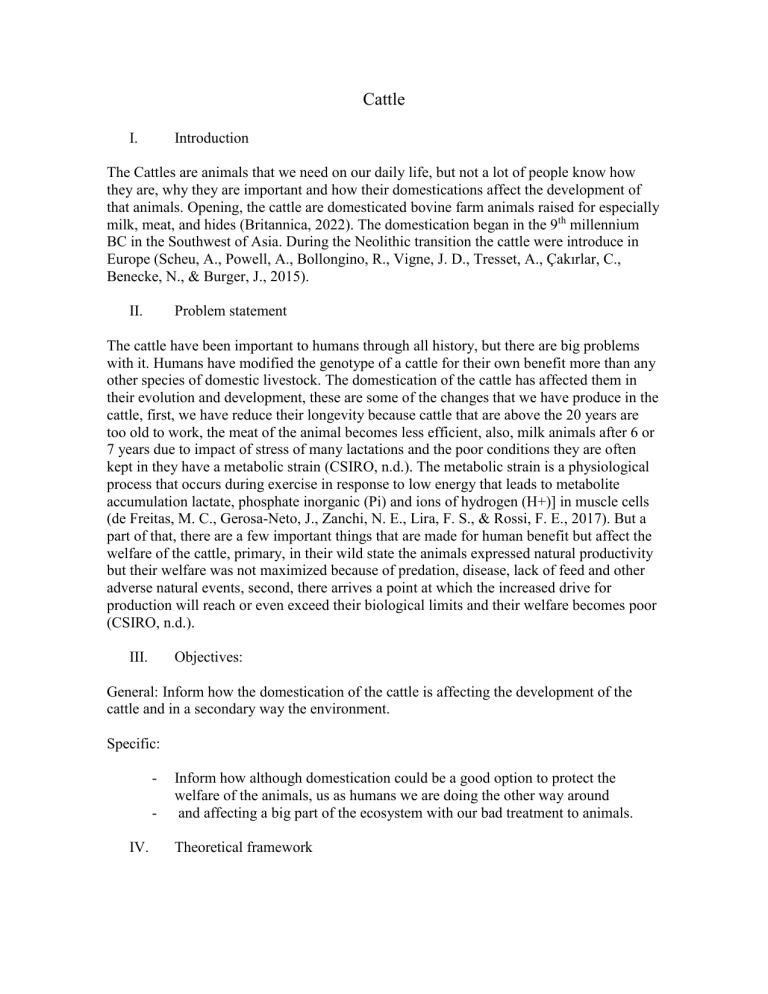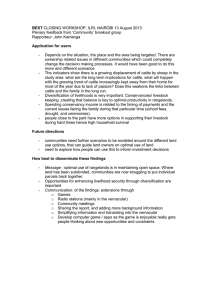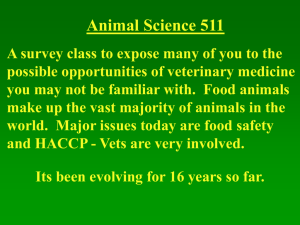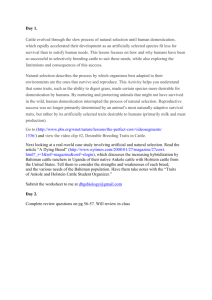
Cattle I. Introduction The Cattles are animals that we need on our daily life, but not a lot of people know how they are, why they are important and how their domestications affect the development of that animals. Opening, the cattle are domesticated bovine farm animals raised for especially milk, meat, and hides (Britannica, 2022). The domestication began in the 9th millennium BC in the Southwest of Asia. During the Neolithic transition the cattle were introduce in Europe (Scheu, A., Powell, A., Bollongino, R., Vigne, J. D., Tresset, A., Çakırlar, C., Benecke, N., & Burger, J., 2015). II. Problem statement The cattle have been important to humans through all history, but there are big problems with it. Humans have modified the genotype of a cattle for their own benefit more than any other species of domestic livestock. The domestication of the cattle has affected them in their evolution and development, these are some of the changes that we have produce in the cattle, first, we have reduce their longevity because cattle that are above the 20 years are too old to work, the meat of the animal becomes less efficient, also, milk animals after 6 or 7 years due to impact of stress of many lactations and the poor conditions they are often kept in they have a metabolic strain (CSIRO, n.d.). The metabolic strain is a physiological process that occurs during exercise in response to low energy that leads to metabolite accumulation lactate, phosphate inorganic (Pi) and ions of hydrogen (H+)] in muscle cells (de Freitas, M. C., Gerosa-Neto, J., Zanchi, N. E., Lira, F. S., & Rossi, F. E., 2017). But a part of that, there are a few important things that are made for human benefit but affect the welfare of the cattle, primary, in their wild state the animals expressed natural productivity but their welfare was not maximized because of predation, disease, lack of feed and other adverse natural events, second, there arrives a point at which the increased drive for production will reach or even exceed their biological limits and their welfare becomes poor (CSIRO, n.d.). III. Objectives: General: Inform how the domestication of the cattle is affecting the development of the cattle and in a secondary way the environment. Specific: IV. Inform how although domestication could be a good option to protect the welfare of the animals, us as humans we are doing the other way around and affecting a big part of the ecosystem with our bad treatment to animals. Theoretical framework - - Metabolic strain: The metabolic strain is a physiological process that occurs during exercise in response to low energy that leads to metabolite accumulation lactate, phosphate inorganic (Pi) and ions of hydrogen (H+)] in muscle cells (de Freitas, M. C., Gerosa-Neto, J., Zanchi, N. E., Lira, F. S., & Rossi, F. E., 2017). The concept of welfare applied to farm animals has undergone a remarkable evolution until it reached a formulation that includes the following fourfold aspect: (a) biological and technical definitions, that emphasize the basic needs of animals and the freedom that should be given and the possibility of coping with environmental challenge; (b) regulation approaches, according which animals are sensitive creatures so they must be reared in the environment compatible to the biological needs of the species. This leads to the translation of the concept into a legal framework; (c) philosophical approach, discussing the role of animals in the humans’ societies; (d) interactive approach, that considers communication between farmers and animals and its impact on livestock systems (Cesarani, A., & Pulina, G., 2021) - Domestication is an evolutionary process during which the biobehavioral profile (comprising e.g., social, and emotional behavior, cognitive abilities, as well as hormonal stress responses) is substantially reshaped. An established model system for the study of domestication, we review (a) how wild and domestic animals of the same species differ in behavior, emotion, cognition, and hormonal stress responses, (b) during which phases of life differences in biobehavioral profiles emerge and (c) whether animal personalities exist in both the wild and domestic form (Kaiser, S., Hennessy, M.B. & Sachser, N., 2015) - Concerning to (a) typical changes with domestication include increased courtship, semipositive and maternal behaviors as well as decreased aggression and attentive behavior. Concerning to (b) differences between the domestic and the wild form can be attributed to genetic alterations resulting from artificial selection, and likely to environmental influences during the pre- and perinatal phase. Concerning to (c) there is some evidence that personalities occur in both wild and domestic animals. However, there may be differences in which behavioral domains – social and sexual behavior, emotionality, stress-responsiveness – are consistent over time. These differences are probably due to changing selection pressures during domestication (Kaiser, S., Hennessy, M.B. & Sachser, N., 2015) V. Description of Variables. The process of domesticating cattle has had a profound impact on their evolution and physical characteristics. Several factors have contributed to the transformation of cattle from their wild ancestors to the domesticated breeds we see today. Firstly, natural selection played a crucial role in favoring traits such as docility, adaptability, and a cooperative nature, as these traits made them more manageable for humans. Selective breeding by early pastoralists further intensified these desired traits, leading to the development of different breeds with specific traits like milk production or meat quality. Another factor was the availability of abundant and consistent food sources provided by human settlements, which allowed cattle to have a more stable and nutritious diet. Additionally, human intervention and artificial selection have influenced cattle's physical features, such as size, coloration, and horn shape, to suit various purposes like plowing, transport, or religious symbolism. Over time, these combined factors have led to significant changes in cattle, shaping them into the diverse and domesticated animals that have become an integral part of human societies worldwide. VI. Discussion This topic is a bit controversial; many people have their own point of view in which they can or cannot agree if domestication is a process needed in the life cycle, and if it is handle in a good way. Our discussion is about what is better for the humans, the animal and the environment, that humans stop eating meat, consuming milk and stop producing clothes with the cattle hide while the economic enter into a break because a lot of farmers depend on that resource, or in the other hand, that we still consuming the meat, the milk and continue producing clothes, but with the thought that the environment is being affected by the greenhouse gas emissions, that the animals are struggling with the stressful conditions the live with. We can go deeper with this information, the domestication has good and bad effects in different aspects of the society, like, economy, critics of reducing meat and dairy consumption raise concerns about the economic impact on farmers who depend on these industries for their livelihoods, “livestock farming supports the livelihoods and provides food security to almost 1.3 billion people” (Greentumble, 2016, par.6). Supporters of alternative agricultural practices, such as plant-based farming or regenerative agriculture, argue that transitioning to these models can provide new economic opportunities while addressing environmental and animal welfare concerns (Livekindly, n.d.). We can talk about of healthy, those advocating for a shift away from meat consumption often cite studies that link excessive meat consumption to health problems like heart disease and certain types of cancer (Victor Chang Cardiac Research Institute, 2022). However, others contend that meat can be a valuable source of essential nutrients, and a balanced diet that includes moderate meat consumption can be part of a healthy lifestyle (NHS, n.d.). As well, the ethical part, advocates for stopping meat consumption argue that killing animals for food is morally wrong and that it perpetuates unnecessary suffering (BBC, 2014). On the other hand, some argue that humans have been part of the food chain for centuries and that responsible animal husbandry can ensure a higher quality of life for animals (Donald R. Strong., Kenneth T. Frank, 2010). And last, the environmental effects, proponents of reducing meat consumption highlight the significant greenhouse gas emissions, deforestation, and water usage associated with livestock production, which contribute to climate change and environmental degradation (Hemi Kim, 2022). Conversely, supporters of the agricultural industry argue that well-managed livestock systems can be part of sustainable land use and that careful resource management, such as rotational grazing, can mitigate environmental concerns (Allan Savory, 2016). With all this information is on you to choose what to do. VII. Conclusions In conclusion, the domestication of cattle stands as remarkable evidence to the collaboration between humans and animals. Through a complex interaction of natural selection, selective breeding, and human intervention, wild cattle were transformed into the diverse and adaptable domesticated breeds that have become an integral part of our societies. The discussions surrounding cattle domestication continue including debates about its origins, the role of humans, cultural and economic significance, genetic consequences, and environmental impact. As we search for understanding the historical and ongoing processes of cattle domestication remains vital. It is through this understanding that we can better appreciate the intertwine history of humans and cattle, and work towards a relationship that ensures the well-being of both species and the ecosystems we coexist within. VIII. Recommendations The education awareness about the process of domestication can contribute to more informed decision-making, improved animal welfare, and the adoption of sustainable and responsible practices in cattle farming. Also, this understanding can lead to more compassionate and responsible treatment of domesticated animals, the conservation of genetic diversity, and the development of sustainable practices in our interactions with domesticated species. We can do this by educational initiatives, public campaigns, community engagement, digital platforms, and resources, and the most important for us the sustainable practices, that emphasize the importance of sustainable and responsible practices in animal husbandry and agriculture. Promote discussions and initiatives focused on animal welfare, conservation, biodiversity, and the preservation of genetic diversity in domesticated species. IX. References Britannica. (2022). Cattle https://www.britannica.com/animal/cattle-livestock Scheu, A., Powell, A., Bollongino, R., Vigne, J. D., Tresset, A., Çakırlar, C., Benecke, N., & Burger, J. (2015). The genetic prehistory of domesticated cattle from their origin to the spread across Europe. https://www.ncbi.nlm.nih.gov/pmc/articles/PMC4445560/#:~:text=Cattle%20domestication %20started%20in%20the,reconstruction%20of%20their%20early%20demography. CSIRO. (n.d.). The implications of cattle domestication. https://www.publish.csiro.au/ebook/chapter/9781486301614_Chapter3#:~:text=As%20well %20as%20changing%20the,horn%20'buds'%20in%20calves. de Freitas, M. C., Gerosa-Neto, J., Zanchi, N. E., Lira, F. S., & Rossi, F. E. (2017). Role of metabolic stress for enhancing muscle adaptations: Practical applications. https://www.ncbi.nlm.nih.gov/pmc/articles/PMC5489423/#:~:text=Metabolic%20stress%2 0is%20a%20physiological,H%2B)%5D%20in%20muscle%20cells. Cesarani, A., & Pulina, G. (2021). Farm Animals Are Long Away from Natural Behavior: Open Questions and Operative Consequences on Animal Welfare. https://www.ncbi.nlm.nih.gov/pmc/articles/PMC8001272/ Kaiser, S., Hennessy, M.B. & Sachser, N. (2015). Domestication affects the structure, development, and stability of biobehavioral profiles. https://frontiersinzoology.biomedcentral.com/articles/10.1186/1742-9994-12-S1-S19 Greentumble. (2016). Advantages and disadvantages of intensive livestock farming. par.6. https://www.veteransoffgrid.org/blog/advantages-and-disadvantages-of-intensive-livestockfarming Livekindly. (n.d.). What Would Actually Happen If Everyone Stopped Eating Meat? https://www.livekindly.com/everyone-stopped-eatingmeat/#:~:text=As%20well%20as%20improving%20individuals,care%2C%20and%20lost% 20working%20days. Victor Chang Cardiac Research Institute. (2022). Heart disease and red meat. https://www.victorchang.edu.au/blog/heart-disease-redmeat#:~:text=Eating%2050%20g%20of%20processed,coronary%20heart%20disease%20b y%2018%25. NHS. (n.d.). Meat in your diet. https://www.nhs.uk/live-well/eat-well/food-types/meatnutrition/#:~:text=A%20healthy%20balanced%20diet%20can,vitamin%20B12%20in%20t he%20diet. BBC. (2014). Eating animals. https://www.bbc.co.uk/ethics/animals/using/eating_1.shtml#:~:text=In%20philosopher's%2 0terms%20it%20is,for%20food%20remains%20morally%20wrong. Donald R. Strong., Kenneth T. Frank. (2010). Human involvement in food webs. https://www.annualreviews.org/doi/10.1146/annurev-environ-031809133103#:~:text=Humans%20prey%20upon%20animals%20at,productivity%20for%20food %20(3). Hemi Kim. (2022). Eating Less Meat Is the Most Effective Way to Fight Climate Change. https://sentientmedia.org/how-does-eating-less-meat-help-climatechange/#:~:text=Eating%20less%20meat%20can%20help,those%20that%20are%20animal %2Dbased. Allan Savory. (2016). What does properly managed livestock mean? https://savory.global/what-does-properly-managed-livestock-mean/



